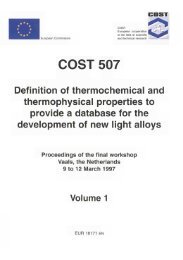Chef de projet : NOM Prnom - Repositório Aberto da Universidade ...
Chef de projet : NOM Prnom - Repositório Aberto da Universidade ...
Chef de projet : NOM Prnom - Repositório Aberto da Universidade ...
You also want an ePaper? Increase the reach of your titles
YUMPU automatically turns print PDFs into web optimized ePapers that Google loves.
Premier Symposium Méditerranéen <strong>de</strong> Géoengineering «SMGE09» Alger 20 et 21 juin 2009<br />
From the analysis of the <strong>de</strong>flections obtained on structures 1 and 2, it was possible to observe,<br />
as expected, that the <strong>de</strong>flections on structure 1 are higher, when the treated soil layer is thinner.<br />
Nevertheless, the difference is not significant, and, therefore, the interpretation was done using<br />
only structure 1, i.e., the most unfavorable one.<br />
Figure 4 <strong>de</strong>picts the <strong>de</strong>flection basin of structure 1, taking into account the various hypotheses<br />
consi<strong>de</strong>red. Furthermore, the normalised <strong>de</strong>flections for 20 kN load of FWD tests performed in<br />
situ on the treated soil (mixture with 4% of lime) are also represented (Pk26525 and Pk26550).<br />
Figure 4. Deflections obtained with PLAXIS ® for different hypotheses (structure 1) and normalized<br />
<strong>de</strong>flections for 20 kN load (layer with 4% lime)<br />
The comparison of the different <strong>de</strong>flection basins – measured in situ and obtained with<br />
PLAXIS® – allowed to conclu<strong>de</strong> that the best fit corresponds to <strong>de</strong>formation modulus values of<br />
lime treated soils of about 200 to 400 MPa.<br />
The equivalent <strong>de</strong>formation modulus calculated using the maximum <strong>de</strong>flection obtained at the<br />
Pk26550 test (375 μm) is 170 MPa. This value is higher than the one specified in the <strong>de</strong>sign.<br />
3.2.2 Highway A10<br />
The <strong>de</strong>sign of this highway specifies that the pavement substructure should present<br />
characteristics that will ensure that the <strong>de</strong>formation modulus at the top of the capping layer<br />
would be higher than 120 MPa at long term.<br />
In a first stage, a test section was constructed in or<strong>de</strong>r to confirm if the substructure <strong>de</strong>formation<br />
characteristics required in the <strong>de</strong>sign could be achieved, and also to assess the effectiveness of<br />
the equipment used and to verify the homogeneity of the work performed. In a second stage,<br />
two evaluation campaigns were performed on previously completed work sections.<br />
As a result, and in accor<strong>da</strong>nce with the layout presented in Figure 5, the pavement structure is<br />
expected to be as follows:<br />
- the bottom capping layer of lime treated soils (LT1) with a 40 cm thickness;<br />
- the top capping layer consist of two layers: a 20 cm layer of lime treated soils (LT2) overlaid by<br />
a 20 cm layer of a well gra<strong>de</strong>d crushed aggregate (ABGC).
















